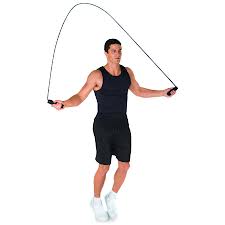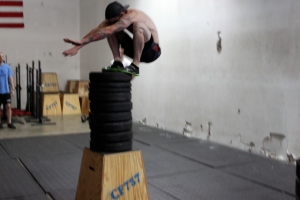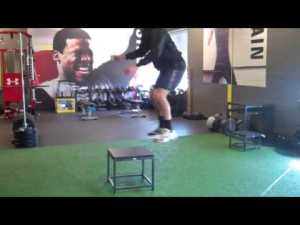In the last post we discussed the need for Coordination for increased vertical. This post discusses plyometrics and its importance for vertical.
Plyometrics are great for improving vertical, however they can often be misused and misunderstood. Correct plyometrics involve full extensions and only a few rep of maximal effort, using plyometrics for improving vertical is not possible if your are using them for conditioning. As well the amazing videos on the internet where people make incredible 50 or 60 inch jumps do not improve vertical. They have flexible hips and while impressive feates of athleticism, it is not as high as you think. Look at the picture the person jumping their feet are almost the same height as their hips.
While if you look at the famous Michael Jordan dunk, his feet and leg are well below his hips.
The key to jump training is to extend the entire body. Big jumps come from powerful hip extension not hip flexion.
With this in mind jump training with plyometrics needs to be planned and purposeful. Throwing random reps and sets in the hopes of improving power and conditioning is not possible. They are a great exercise if prescribe properly with progressions and regressions.
The first part of plyometric training is often the most overlooked, landing mechanics. Landing is huge because if you cannot land properly you will eventually hurt yourself. An excellent way to do this is to start with skipping, the skipping rope is a great way to develop ankle hops and absorbing the ground forces.
 Start with a general ankle hop of 3 sets of 20 skips, working your way up to 50 skips. Learning how to land is extremely important. Use skipping as a warm up is a great way to work on landing.
Start with a general ankle hop of 3 sets of 20 skips, working your way up to 50 skips. Learning how to land is extremely important. Use skipping as a warm up is a great way to work on landing.
Box Jumps
Box jumps Help you to extend the hips developing explosive power. Remember you are wanting to get full extension and land in either a half or quarter squat. Landing deep can potentially cause serious knee injuries. remember training is about improving, its not a competition, technique and quality reps are needed. Getting hurt in training means not playing in the sport you play.
Box jumps are a great way to start plyometrics, they generate explosiveness in the hips but are easier on the joints because you are limiting the landing forces. This will allow your body to adapt, limit knee pain or injuries Another thing to remember is that to develop the maximum power you are looking for you need to only do a few reps and sets, treating box jumps as a conditioning drill is not helping explosive power instead its putting extreme strain in the joints, the trade off of risk and reward for box jumps is just not work it. Aim for 2-3 sets of 4-8 reps for box Jumps. As well never jump down from the box, step down instead, jumping down is a completely different exercise called the depth jump, which is for highly advanced athletes
Mini hurdle jumps
Once you have mastered the box mini hurdle jumps should be your next step. There are many variations of mini hurdle jumps. I prefer to start with a 2 foot jump and stick the landing. While this may not be a true plyometric, I like it because it reinforces proper mechanics allowing the athlete to feel a full jump extension and landing without worrying about the next jump. Once you have mastered this then you can work on repeated jumps over continuous hurdles. As a general rule i try not to go more than 5 hurdles, again i want quality not quantity.When it comes to continuous jumps i prefer to start with double or mini hop jumps, once you land do a little hop to absorb the forces and then a second more explosive jump. Mastering the continuous 2 foot jump means you can now move to the single leg variations of these same jumps. One thing to keep in mind is if the athlete is having troubles with the jumps try to limit the moving parts, such as arm swings, remove them if the athlete is having trouble coordinating them, adding them back in once the athlete is competent with the no arm swing jumps
Bounding
If you have mastered mini hurdles it is time to add bounding exercises. There are many variations of bounding, but the biggest thing to remember about bounding exercises is that you are trying to land and explode quickly limiting the time you stay in contact with the ground.
The biggest thing to remember is that plyometrics are for power. You can only work on power not power and endurance. Work on extending through the hips and stick the landing.




Pingback: Increasing Your Vertical – Part 5 Strength Training | Revolution Conditioning & Health